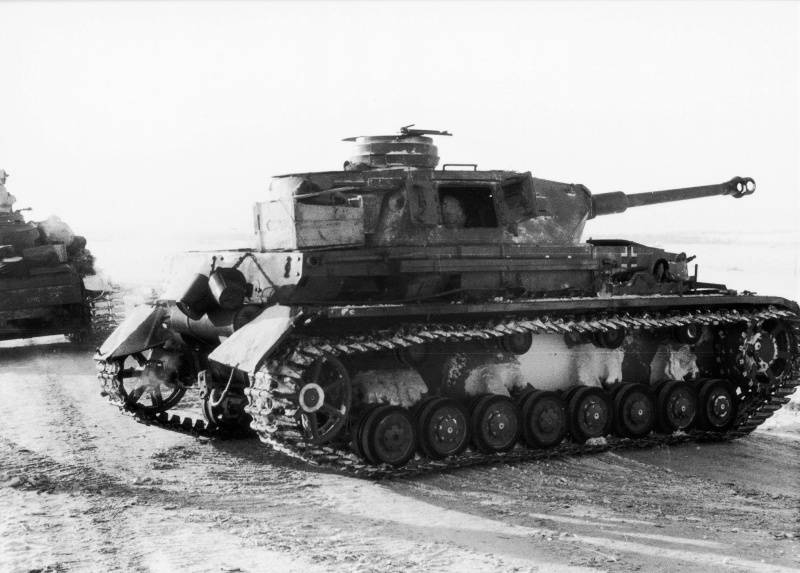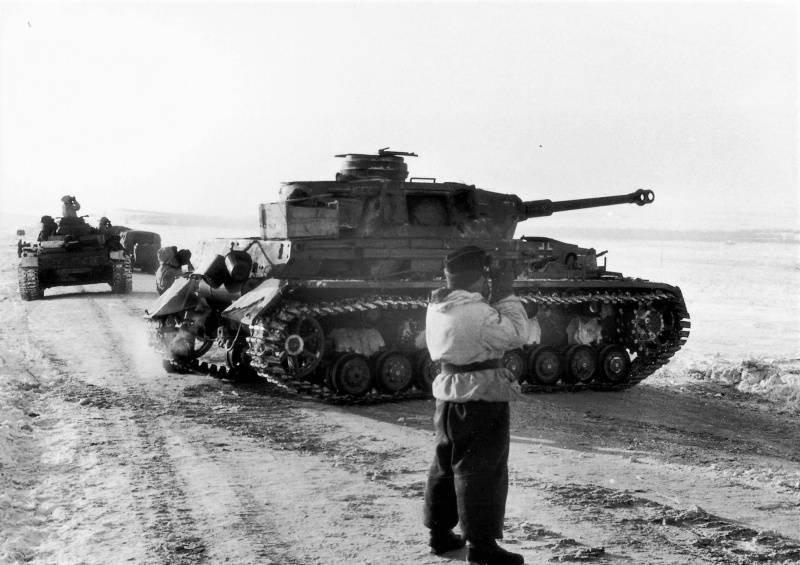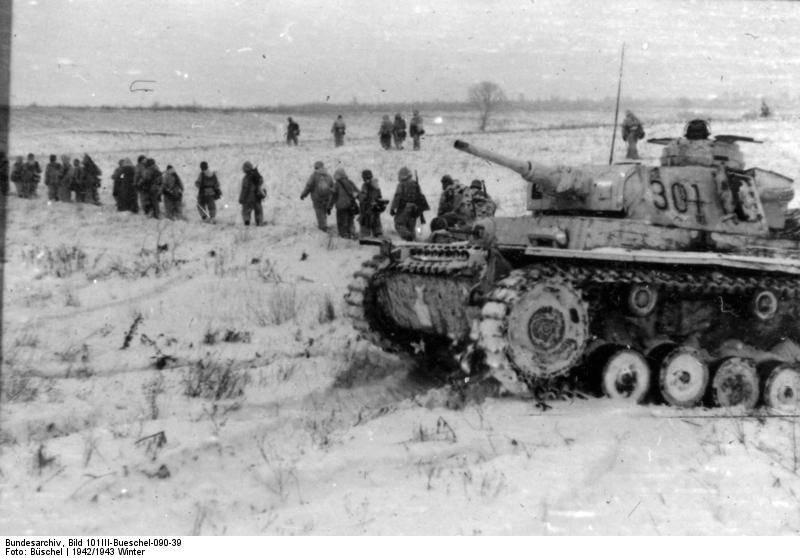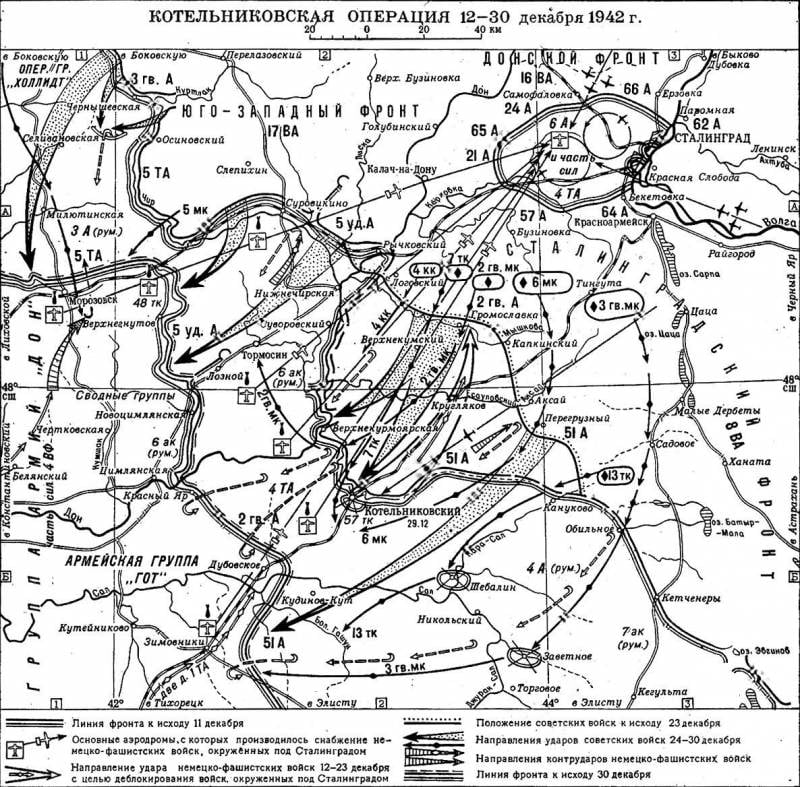As the Germans tried to save the army of Paulus. Operation "Winter Thunderstorm"
German Command Actions
23 November 1942 in the Kalach-on-Don area, Soviet troops locked the encirclement around the Wehrmacht 6 Army. The command of the 6 Army was preparing to break through the encirclement ring. The breakthrough was supposed to take place on November 25, after regrouping necessary to concentrate the strike forces in the south-west. It was planned that the army would come out at dawn by the right flank east of the Don to the south-west and forcing the Don in the Upper-Chirskaya area.
On the night of November 23-24, Paulus sent Hitler an urgent radiogram in which he asked for permission to break through. He noted that the 6th Army was too weak and could not hold the front for a long time, which had more than doubled as a result of encirclement. In addition, over the past two days she suffered very heavy losses. It was impossible to remain surrounded for a long time - large supplies of fuel, ammunition, food and other supplies were needed. Paulus wrote: “The fuel reserves will run out soon, Tanks and heavy weapon in this case will be fixed. The situation with ammunition is critical. Food is enough for 6 days. ”
Hitler, in the evening of November 21, when the headquarters of the 6 Army, which was on the way of the Soviet tanks, moved from the Golubinsky area to the Lower Chirskaya, gave the order: “The army commander with headquarters will head to Stalingrad, the 6 Army will take all-round defense and wait for further instructions. ” In the evening of November 22, Hitler confirmed his first order: "The 6 Army will take all-round defense and wait for the unblocking offensive from the outside."
On November 23, the commander of Army Group B, Colonel-General Maximilian von Weichs sent a telegram to Hitler’s headquarters, where he also spoke of the need to withdraw troops from the 6 Army without waiting for outside help. He noted that the supply of the army, numbering twenty divisions, by air is impossible. With the existing fleet of transport aircraft in case of favorable weather, only the 1 / 6 portion of the food needed for one day can be transferred to the “boiler” daily. Army stocks will quickly run out and can be stretched only for a few days. Ammunition will be quickly spent, as the surrounded troops repel attacks from all sides. Therefore, the 6 th army must make its way to the south-west in order to preserve it as an effective force, even at the cost of losing most of the equipment and equipment. Losses due to a breakthrough, however, “will be much smaller than with a hungry blockade of the army in the boiler, to which otherwise events developing now will lead”.
The Chief of the General Staff of the Ground Forces (OKH), the infantry general Kurt Zeitzler also insisted on the need to leave Stalingrad and abandon the 6th Army to break through the encirclement. Details of the operation to exit the 6th Army from the encirclement scheduled for November 25 were agreed between the headquarters of Army Group B and the 6th Army. On November 24, they were waiting for Hitler’s permission to surrender Stalingrad and the order for the 6th Army to leave the encirclement. However, the order never arrived. On the morning of November 24, a report was announced by the Air Force command that the German aviation will provide the supply of surrounded troops by air. As a result, the main command - Hitler, the head of the OKW (high command of the Wehrmacht) Keitel and the chief of staff of the operational leadership of the OKW Iodl - finally inclined to the opinion that the 6th army would hold out in the encirclement area until it was released by releasing large forces from outside. Hitler told the 6th Army: “The army can believe me that I will do everything in my power to supply it and timely release ...”
Thus, Hitler and the Supreme Command of the Wehrmacht hoped not only to free the 6 Army from the encirclement, but also to restore the Volga front. Paulus proposed to withdraw the troops, but at the same time he himself admitted that "under certain conditions, there were prerequisites for the planned operation to unblock and rebuild the front." German commanders needed positions on the Volga in order to maintain the strategic initiative, and as the basis for further offensive warfare. The supreme military and political leadership of the Third Reich still underestimated the enemy. Hitler and his generals clearly saw the situation and the threat of disaster. However, they did not believe in the Russian offensive capabilities, and they believed that the available forces and reserves of the Red Army were thrown into the Battle of Stalingrad, that they would not be enough to win a complete victory.
At the cost of great efforts, the German command was able to restore the front and stop the further advance of the Soviet troops south-west and south of Stalingrad on the external front of the encirclement. At the turn of the river. Chir was suspended from retreating the 3 of the Rumanian army that had been crushed and thrown back by Soviet troops. In the bend of the Don between the mouth of the river. Chir and district art. Veshenskaya (mainly along the river. Chir) the enemy organized a defense. In addition to the 3 of the Romanian army, German combat groups were quickly brought together (each up to a reinforced regiment). Then a fresh 17 Army Corps arrived in the same area, occupying a defense along the r. Chir and r. Curve near Dubovsky. Part of the German 48 tank corps, defeated by Soviet troops during the operation of the environment, occupied the gap between the 3 of the Romanian army and the 17 of the army corps. Thus, at the turn of the river. Chir, the enemy command created a new front of defense near Stalingrad. German troops also managed to create a steady line of defense in the area of encirclement.
Meanwhile, in the Kotelnikov district, east of the Don, the 4 I tank army under the command of Colonel General Goth was preparing to strike. In the coming days, she had to break through the ring of encirclement and launch an offensive on a broad front. At the same time, an army group under the command of General of Infantry Hollidt was to attack from the area west of the upper course of the Chir from the flank of the enemy advancing to the south. The 48 tank corps under the command of the general of tank forces von Knobelsdorf (with headquarters in Tormosyn), together with the newly arrived 11 tank division and still expected connections, had to attack from the bridgehead east of the Lower Chirskaya. However, in the Tormosin area, the Germans did not succeed in creating such a strong deblocking group as it was concentrated in the Kotelnikovo area. Attempts to attack in this direction were unsuccessful. In continuous battles, the German 11 I tank division suffered heavy losses.


German tank Pz.Kpfw. IV Ausf. G (Sd.Kfz. 161 / 2) during the repulse of the Soviet offensive near Stalingrad, near the village of Kotelnikovo. By car installed "eastern" tracks (Ostketten). In the background, the tank Pz.Kpfw. III
Formation of the army group "Don"
The preparation and conduct of the deblocking operation was entrusted to the group of armies "Don", created by the order of the OKH from 21 November 1942. It was located between army groups "A" and "B". The command of this army group was entrusted to Field Marshal Erich von Manstein. It included the Hollidt Task Force (in the Tormosin region), the remnants of the 3 Romanian Army, the 4 German Tank Army (newly created from the management of the former 4 Tank Army and troops arrived from the reserve) and 4- I am the Romanian army in the 6-th and 7-th Romanian corps. As a strike force, the Hollidt group had the 48 tank corps (with the 11 tank division) and the 22 tank division; The 4 Tank Army is the 57 Tank Corps (6 and 23 Tank Divisions).
To reinforce the group of armies "Don", divisions were hurriedly redeployed from the Caucasus, from near Voronezh, Orel and from Poland, Germany and France. Manstein was also subject to the troops, surrounded in the area of Stalingrad (6-I army). The group was reinforced by significant reserve artillery forces. Army Group "Don" occupied the front of a total length of 600 km, from the village of Veshenskaya on the Don to the river. Manych It consisted of up to 30 divisions, including six tank and one motorized (16-I moto division), not counting the troops surrounded at Stalingrad. 17 divisions from the army group “Don” were in front of the troops of the Southwestern Front, and 13 divisions (united in the army group “Got”) opposed the troops of the 5 shock army and the 51 army of the Stalingrad Front.
The freshest and most powerful division was - 6-I tank division of Major-General Raus (160 tanks and 40 SAU). This division, along with the 23 armored division, and then the 17 armored division, was part of the 57 armored corps of the general of the tank troops of Kirchner. This corps became the main armored fist, with the help of which the German command tried to break through the encirclement. After heavy winter battles in 1941-1942. in Moscow, the 6 Tank Division in May 1942 was transferred to France to replenish and re-equip, the 11-Tank Regiment, which had the Škoda-35 Czechoslovak machines, received instead of them new German vehicles. The connection had strong frames. Along with experienced chiefs-corporals, it had a personnel core of non-commissioned officers and officers. Units were knit, had combat experience. X. Scheibert (commander of the 8 Tank Company of the 11 Tank Regiment) in his book: “To Stalingrad — 48 kilometers. The deblocking blow of the 6 Panzer Division, December 1942 of the year "noted:" The division’s combat capability can be assessed as outstanding. Everyone felt his great superiority over the enemy, believed in the power of his weapon, in the readiness of commanders. ”
27 November morning echelon 6-th tank division arrived in Kotelnikovo. Just at this time, after the shelling, Soviet units broke into the city. Within a few minutes, the division suffered its first losses. The 6 Panzer Division, by 5 December, was fully concentrated in the Kotelnikovo area, its motorized infantry and artillery took up defensive positions about 15 km east of the city.
Erich von Manstein, who was put in charge of the Don group by Hitler and received the order to unblock the Stalingrad group of Paulus, was a proven commander who gained fame in many operations. Manstein, as commander of the 11 army, became famous when he conquered the Crimea. For the capture of Sevastopol, Manstein was promoted to the rank of field marshal. Then the 11 th army under the command of Manstein, as having successful experience of siege and assault actions, was transferred for a decisive assault on Leningrad. However, the Soviet offensive of the Volkhov Front disrupted the plans of the German command. Paulus characterized him as a military leader, who "enjoyed the reputation of a man of high qualification and operational intelligence and able to defend his opinion before Hitler."

"Winter Thunderstorm"
On December 1, the command of the army group issued an order to conduct the operation “Winter Thunderstorm” (Operation “Wintergewitter”, with it. Wintergewitter - “winter storm”). The plan of operation provided for the following: The 4-I tank army was to launch an offensive with the main forces from the Kotelnikovo area east of the r. Don. The beginning of the offensive was scheduled no earlier than December 8. Army troops were asked to break through the front of the cover, strike the rear or the flank of the Soviet troops occupying the inner front line south or west of Stalingrad, and defeat them. The 48 tank corps of the Hollidt group were to strike the rear of the Soviet troops from a bridgehead on the Don and Chir rivers in the Nizhne-Chirskaya area.
6 th army in accordance with the proposed retain their previous position in the "boiler". However, a certain point, indicated by the headquarters of the army group, the 6-I army had to attack in the south-western sector of the encirclement in the direction of the r. Don Queen and connect with the advancing 4-th tank army.
Thus, Manstein decided to deliver the main blow from the Kotelnikovo area. Although the German troops, entrenched at the turn of the river. The Chir near Nizhne-Chirsk, were only 40 km from the surrounded Paulus troops, while the Kotelniki group (the Goth army group) was removed from them before the offensive at a distance of 120 km. Nevertheless, Manstein decided to attack from here.
This was largely due to the difficult situation on the river. Chir, which evolved for the German troops. As soon as the Soviet troops strengthened the encirclement ring, they immediately began attacking enemy positions along the r. Cheer The center of these attacks was the lower course of the river and a springboard in its mouth at the Don. As a result, the Germans have exhausted all the offensive opportunities here. The troops, united under the command of the 48 tank corps, repulsed these attacks. However, when the strike group "Hollidt", intended as the main force for the unblocking operation, managed to come to the German defensive front along the r. Chir, the newly created 48 tank corps has already exhausted its strength. Thus, the 48 tank corps was not only unable to assist the unblocking counterstrike with the operation from the Chirsk bridgehead, moreover, he had to surrender this position, which was closest to the troops in Stalingrad, already on December 15.
The German command postponed the start of the deblocking strike to December 12. This had to be done because of the delay in the concentration of troops intended for the offensive. Hollidt's group did not have time to take the initial positions for the offensive due to insufficient road capacity, and the 4-I tank army was waiting for the arrival of the 23-th tank division, which was delayed due to the thaw in the Caucasus. In addition, Manstein had to abandon the idea of two strikes. Thus, of the seven divisions intended for the Hollidt group, two were already engaged in battles at the front of the 3 of the Romanian army, and the operational status did not allow them to be recalled. The 3-I Mountain Division did not arrive at all, by order of the OKH it was transferred to Army Group A, and then Army Group Center. Army Group “A” also detained artillery from the reserve of the high command. The revitalization of the Red Army at the front of the 3 of the Romanian army exhausted the capabilities of the 48 tank corps, which could not simultaneously repel attacks and launch a counter-offensive. Thus, Manstein decided to abandon two deblocking attacks. It was finally decided that the main attack should have been delivered by the 4-I tank army.
11 December Manstein gave the order to start the operation. The situation in the southern sector of the front deteriorated, and it was necessary to advance. It was decided to strike the blows with the 6 and 23 armored divisions, to which the 17 armored division subsequently joined. Manstein offered General Paulus a counterstrike from the Stalingrad area.
To be continued ...

Information